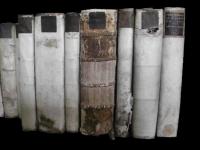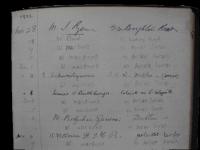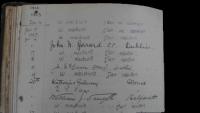In the line of fire
Published in 20th-century / Contemporary History, Features, Issue 3 (May/June 2012), Revolutionary Period 1912-23, Volume 20
One of the books (second from right) ‘injured’ during ‘the Sinn Féin Rebellion’.
The minutes of the annual meeting of the trustees of Marsh’s Library in October 1916 noted the ‘damage caused to the Library and its contents by the Sinn Féin Rebellion’. The library was directly in the line of fire between the insurgents’ position at Jacob’s biscuit factory and the barracks of the Dublin Metropolitan Police on Kevin Street. The area around Jacob’s had been relatively quiet all Easter Week, possibly because of a British decision to ‘lock down’ the area in order not to endanger St Patrick’s Cathedral, but on Sunday 30 April a British army machine-gun ‘inadvertently’ fired on the library from St Patrick’s Park. The result was significant damage to the roof and the windows of the reading room. More seriously, bullets struck a bookshelf, ‘injuring five books’.The books ‘injured’ in 1916 (part of the original collection of the first librarian, Dr Elias Bouhereau, a Huguenot refugee) have deliberately never been repaired. Each book has a relatively compact entry hole of 1.5cm on its spine, but the exit hole at the back is five to six times larger. The 400 or so pages within the covers of each book were simultaneously ripped to shreds by the trajectory of the bullets and compressed by the pressure waves generated by the projectiles. The machine-gunner was stationed about 350 metres away from the points of impact, and the shattered books provide an inkling of the effect of a bullet on frail human flesh and bone.

The register in which readers at Marsh’s Library were obliged to sign their names every day provides an intriguing vignette of how one man negotiated the momentous choices regarding identity and allegiance forced upon people during these years. On 24 November 1922, a William Burd of 43 Lindsay Road, Glasnevin, went to the library for the first time. He signed in using this name on each subsequent working day until, on the morning of 29 November, he wrote his name in the Gaelic script as ‘W MacBurd’ of ‘Bothar Linsai’. He continued to sign his name and address in this way every day for the next two weeks before he altered his address to ‘Gleas na naoman’. Over the next month MacBurd altered the Irish form of ‘Glasnevin’ three times until he settled on ‘Glais Naeidín’. It had taken him a while, but he had eventually settled on an identity and a place within the new state.
The use of the adverb ‘inadvertently’ tells us much about the sympathies of the library staff. Indeed, less than two months after the end of the Rising the librarian noted that the assistant librarian, Mr Richard Fitzpatrick, ‘resigned to join H.M. Army’. In doing so, he followed in the footsteps of three members of the staff who joined up very soon after the outbreak of hostilities in 1914. There was, of course, no unanimity among Protestants on political matters during the Anglo-Irish War and the subsequent Civil War. Some supported independence and went so far as to advocate or use violence to achieve that end. Most, however, undoubtedly supported the status quo and saw no contradiction between being simultaneously Irish and British. The majority of Protestants, however, just like their Catholic fellow citizens, were anxious to accommodate to the realities of life in Saorstat Éireann.Nevertheless there were anxieties. In October 1922, for example, the librarian made an oblique reference to the recent ‘malicious injuries to the windows’ of the library. More research needs to be done on the exact nature of this incident, but the staff evidently believed that the damage was motivated by anti-Protestant sentiment. Marsh’s was a nervous place during the Civil War. In January 1949 Patrick O’Connor of the National Library wrote to the librarian about his first visit ‘in the early spring of 1923’ and how he had difficulty in gaining entry because he was wearing a trench coat and a battered fedora, a style of dress that made him look like the archetypal gunman, at a time when properties associated with Protestants were being burned by Republicans across the country.The sense of vulnerability and fear to which O’Connor’s letter testifies may go some way towards explaining a curious incident in the history of the library. In late 1924 Mr Hugh Kennedy, the recently appointed first chief justice of the Irish Free State, wrote to the librarian, asking why he had not been summoned to the recent annual meeting of the library’s trustees. The reply from Marsh’s was formal and terse; it acknowledged that the chief justice of Ireland had been an ex officio trustee of the library, but ‘that office has now been abolished; and … the office of Chief Justice of the Irish Free State is not identical with that of the Lord Chief Justice of Ireland’. Mr Justice Kennedy wrote back almost immediately to say that under the terms of the Treaty his office had replaced that of the lord chief justice, but suggested that if the trustees did not concur with this assessment the Free State government would be willing ‘to insert a clause in a coming bill setting any doubt in the matter at rest’. The trustees of the library declined to enter into any further correspondence on the matter and, in so doing, effectively cut themselves off from any positive engagement with the new state.
 The bridges burnt in 1924 were not fully repaired until 1969, when the library invited the then chief justice of Ireland, Cearbhall Ó Dálaigh, to attend the next annual meeting as an ex officio trustee. Over the past four decades, the library has developed a close working relationship with a variety of state agencies and government departments. The Office of Public Works has undertaken significant repairs, which have ensured that the building remains habitable, and the Department of Arts, Heritage and the Gaeltacht provides an annual grant that enables it to open to the general public as a tourist attraction. The library, like the community with which it has long been associated, is entirely confident within the Irish Republic.The modern archives of Marsh’s Library were closed to scholars until very recently. It was felt that the documentation about the relationship between the Protestant community and the nascent state was far too raw, controversial and contemporary to be in the public domain. The decision to open this small but significant archive is intended to contribute, in time for the centenary commemorations of 1916, to a more nuanced and rounded assessment of the experience of all Irishmen and women. HI
The bridges burnt in 1924 were not fully repaired until 1969, when the library invited the then chief justice of Ireland, Cearbhall Ó Dálaigh, to attend the next annual meeting as an ex officio trustee. Over the past four decades, the library has developed a close working relationship with a variety of state agencies and government departments. The Office of Public Works has undertaken significant repairs, which have ensured that the building remains habitable, and the Department of Arts, Heritage and the Gaeltacht provides an annual grant that enables it to open to the general public as a tourist attraction. The library, like the community with which it has long been associated, is entirely confident within the Irish Republic.The modern archives of Marsh’s Library were closed to scholars until very recently. It was felt that the documentation about the relationship between the Protestant community and the nascent state was far too raw, controversial and contemporary to be in the public domain. The decision to open this small but significant archive is intended to contribute, in time for the centenary commemorations of 1916, to a more nuanced and rounded assessment of the experience of all Irishmen and women. HI
Jason McElligott is Keeper of Marsh’s Library.
















